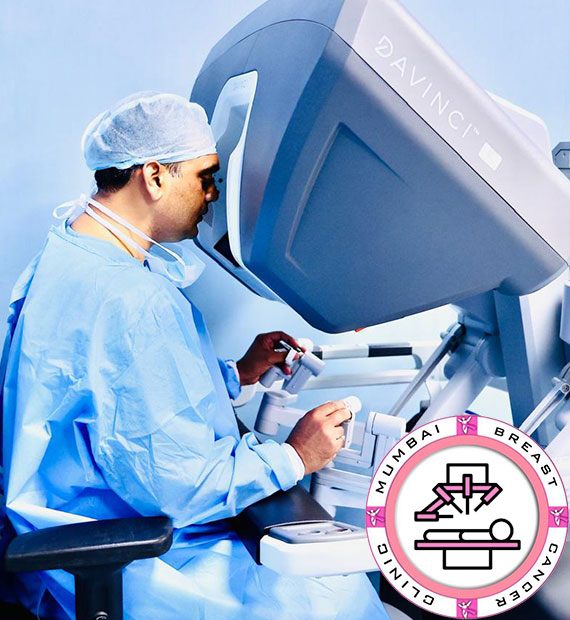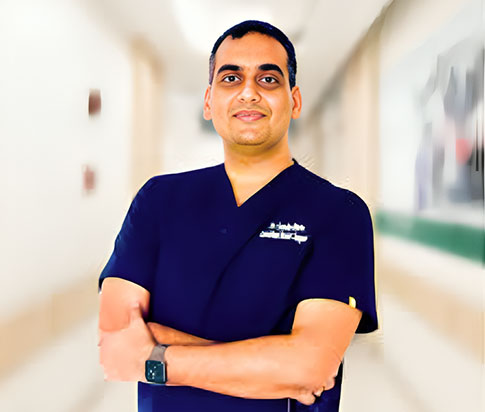Robot-assisted surgery or robotic surgery are any types of surgical procedures that are performed using robotic systems.
Know More
Cumballa Hill
60 A, Bhulabhai Desai Marg, Breach Candy, Cumballa Hill, Mumbai, Maharashtra 400026
Get a Direction
Tardeo, Mumbai
15, Pedder Rd, IT Colony, Tardeo, Mumbai, Maharashtra 400026
Get a Direction
Parel, Mumbai
35, Dr Ernest Borges Rd, opp. Shirodkar High School, Parel East, Parel, Mumbai, Maharashtra 400012
Get a Direction
Belapur
Plot #13, Parsik Hill Rd, off Uran Road, opp. Nerul Wonders Park, Sector 23, CBD Belapur, Navi Mumbai, Maharashtra 400614
Get a Direction
Robotic breast surgery is rapidly gaining popularity around the world for its precision, minimal scarring, and faster recovery times. It can be offered to carefully selected patients with breast cancer, as well as to those seeking risk-reducing mastectomy due to genetic mutations such as BRCA1 or BRCA2.
A traditional mastectomy usually requires larger incisions across the chest, which may lead to visible scarring, loss of sensation, and longer recovery. In contrast, robotic mastectomy uses advanced robotic technology to perform the procedure through a small incision hidden under the armpit. This technique allows surgeons to preserve important nerves around the breast, helping maintain sensation and supporting a more natural reconstruction — all in a single surgery.
By using the Da Vinci robotic system, surgeons gain enhanced vision, precision, and control. The system provides up to seven degrees of freedom, tremor elimination, 3D magnified vision, ergonomic comfort, and high-definition imaging. These advantages significantly reduce the risk of complications like bleeding or skin injury, minimize scarring, and promote a quicker, smoother recovery — helping patients return to their lives with greater confidence.
Robotic nipple-sparing mastectomy (RNSM) was first performed by Toesca et al. in 2015, and it marked a major step forward in breast cancer surgery. This technique allows surgeons to remove the breast tissue while preserving the skin, nipple, and areola through a single, hidden axillary scar, followed by immediate breast reconstruction with implants.
Clinical studies have demonstrated the safety, feasibility, and reproducibility of this approach. In a series of 29 cases, RNSM was completed in about three hours on average, with very few needing conversion to open surgery and no major complications such as infections.
This minimally invasive technique offers outstanding cosmetic results and can greatly improve a patient’s body image and overall quality of life after surgery.
You may be a candidate for robotic mastectomy if:
Every patient is unique. A full consultation, including imaging and clinical evaluation, will help determine if robotic mastectomy is the right choice for you.
Dr. Sandip M. Bipte is a specialist Oncoplastic breast surgeon with extensive experience in medical & surgical aspect breast oncology. More ever, Dr. Bipte has also undergone speciality training in Intraoperative Radiotherapy (IORT) at Whittington Hospital, London, UK, which is a one of the novel treatment for early breast cancer.
Recently Dr Sandip Bipte became the first Surgeon in the entire Maharashtra to do a Robotic Breast Surgery, which has been widely publish in various news article. A 43-year old woman underwent Robotic Procedure for Breast Cancer at Navi Mumbai Hospital.
He has Clinical excellence in diagnosis & management of benign and malignant breast diseases with over 500-600 breast surgeries performed yearly along-with clinical research, publications and medical conferences. Dr. Bipte has been part of national & International conferences & training programme. He was invited as faculty in various national breast cancer conferences.

Robotic breast surgery is a minimally invasive procedure where the surgeon uses a robotic system to perform the surgery with high precision. The robot is controlled by the surgeon and allows for smaller incisions, better accuracy, and a quicker recovery compared to traditional methods.
Robotic procedures may take slightly longer than traditional surgery due to setup time. On average, it takes between 2 to 4 hours depending on the complexity of the case.
Robotic techniques are most commonly used for:
Yes, robotic surgery is considered safe and has been used for many years in various specialties. The system is controlled entirely by the surgeon and is equipped with safety mechanisms to prevent unintended movements.
Most patients experience:
As with any surgery, there are risks including:
Your surgeon will discuss all potential risks before the procedure.